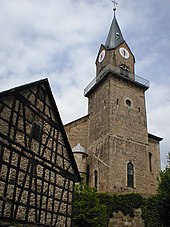Mauritius Church (Güglingen)
The Protestant Mauritius Church in Güglingen in the Heilbronn district in northern Baden-Württemberg was first mentioned in 1241. It got its present form through the reconstruction after the city fire of 1849 and through a comprehensive modernization in 1976/77.
history
Little is known about the origins of the Mauritius Church, but a church was built in Güglingen as early as the 8th century. The church was first mentioned in a document in 1241. There is also little evidence of its appearance in the Middle Ages. In 1295 Count Rudolf von Neuffen donated the church patronage to the Holy Sepulcher Monastery in Speyer , which was ceded to Württemberg in the course of the Reformation in 1541. The oldest part of the church is a small Renaissance portal from 1598. In 1751 the church was renewed, at that time the tower was built in its current dimensions. In the town fire in 1849 the church was almost completely destroyed, only the tower base and the old portal from 1598 remained.
In 1850, Abel had the church rebuilt in camera style, and in 1976/77 Heinz Rall renovated it comprehensively. A false ceiling was installed in the nave in order to use the upper floor created as a community room. The western part of the nave was separated and also rededicated as useful rooms for the community. The remaining hall was designed by the artists Lude Döring , Gerhard Dreher , Ursula Stock and Gunther Stilling in a modern way. In 1988 the equipment was supplemented by the Güglinger palm cloth , which consists of partial images from 40 different artists.
Bells
The oldest bell recorded in Güglingen is the Herzog-Christoph-Glocke , which came to Güglingen in 1557 from the Kirchbach monastery near Ochsenbach as a gift from Duke Christoph . Other historical bells were probably lost during the time of the French invasions and were replaced in 1706 by two new bells that were cast by Johannes and Franz Ludwig Rosier in Rottenburg. The smaller of these bells was cast in 1817 by Christian Gottlieb Neubert in Ludwigsburg. The old Herzog-Christoph bell broke at Christmas 1839 and was cast in the following year by Heinrich Kurtz in Stuttgart. When the city fire in 1849, all the bells in the church melted.
In 1850 the church received four new bells from Kurtz in Stuttgart. The Eusebia bell had the strike note d ', a diameter of 130 cm and a weight of 1100 kg. The Urania bell had the strike note a ', a diameter of 85 cm and a weight of 384 kg. The Concordia bell had the strike note d '', a diameter of 65 cm and a weight of 294 kg. The Caritas bell was cast again in 1851 and then had the strike tone f sharp 'and a weight of 431 kg. The three smallest bells were melted down during the First World War in 1917 , so that only the Eusebia bell remained in the tower.
In 1922 the new Urania bell , which had the strike note a ', a diameter of 90 cm and a weight of 450 kg, was the first replacement from Kurtz in Stuttgart. In 1924, the new Caritas bell with a striking sound f sharp ', a diameter of 107 cm and a weight of 620 kg, and the new Concordia bell with striking sound d' ', a diameter of 65 cm and a weight of 156 kg followed from the same foundry . During the Second World War , the three largest bells were melted down, so that only the Concordia bell from 1924 remained in Güglingen.
As the first Güglinger replacement bell after the Second World War, Kurtz cast the cross bell in Stuttgart in 1948 with a striking note b ', a diameter of 89 cm and a weight of 380 kg. 1950 followed by Kurtz's drawing and arbitration bell with a c '' strike , a diameter of 76.8 cm and a weight of 276 kg. In 1958, for the fused in the same year Concordia bell when the bell foundry Bachert cast in Heilbronn cross bell with the percussive g ', a diameter of 108 cm and a weight of 700 kg added. Today's five-part chime was completed in 1977 by two bells cast by Bachert in Bad Friedrichshall- Kochendorf. The Dominika bell has the strike tone es', a diameter of 146.3 cm and a weight of 1404 kg. The christening bell has the strike tone 'es', a diameter of 70.6 cm and a weight of 208 kg.
Individual evidence
- ↑ Regest of the deed of gift
- ^ Regest of the sales deed
- ^ Norbert Jung: hilf got vnd maria, contributions to the history of bells in the city and district of Heilbronn , Heilbronn 2008, pp. 49–53.
literature
- Heinz Rall: Historic churches in Zabergäu and the surrounding area . Forum-Verlag, Stuttgart 2003, ISBN 3-8091-1088-4 , pp. 30/31.
Web links
- Mauritius Church Güglingen on the website of the Evangelical Church Community Güglingen
Coordinates: 49 ° 3 '58 " N , 9 ° 0' 2.4" E
